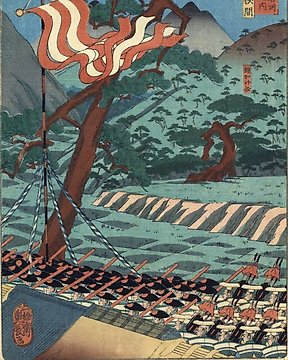
Xilografía original - Papel - Utagawa Ikkyōsai Tsuyanaga 一橋斎艶長 (act 1860s) - Okehazama 桶狭間 - From “Tōkaidō meisho no uchi” 東海道名所之内 (Famous Places on the Tokaido) - Japón - 1863 (Bunkyū 3)
N.º 82650691

N.º 82650691

Original woodblock print, Supervised by Narazaki Muneshige - Paper - Yamanaka Kodo (1869-1945) - 'Joyū' 女優 (actress) - Japan - ca 1989 (Heisei 1)
Yamanaka Kodō (山中古洞)
Supervision: Narazaki Muneshige
First edition 1929.
This is a later edition, printed using the original woodblocks.
This was made in ca. 1989
Carver: Watanabe Yoshiaki 渡辺義明
Printer: Koike Shigeru 小池茂
See Minneapolis Institute of Arts: https://collections.artsmia.org/art/62463/actress-sakai-yoneko-yamanaka-kodo
A disciple of Yoshitoshi Tsukioka. His real name is Sato, his surname is Yamanaka, and his first name is Masu. He uses the signatures of Kodo, Nihongaken, and Tatsuomo. Born in Nagatacho, Kojimachi, Tokyo, as the son of Seiichiro Sato, a feudal lord of Hitotsubashi. He is said to have worked for the Ministry of Finance. After studying painting in Yoshitoshi, he became a disciple of Naohiko Kumagai, Kogan in Hara, and Hakudo Ishihara. His style of painting seems to have been largely due to the influence of Yoshitoshi, and it is said that his portrait is good. He became a member of the Kokufukai. As an ukiyo-e artist, he has exhibited his work at the Karasukai. He also received a reward for exhibiting the “Kiyosei Sengun Zu(清正図)” at the National Industrial Exhibition held in Kyoto in 1895.
At the end of 1896, the following year, Koyo Ozaki and Sanae Takata joined the Yomiuri Shimbun after discussions, but there was not much work to do, and Koyo, the introducer, and Kinjo Nakai, the editor-in-chief, were worried. Then, Koyo submitted the “Western girl temperament”, which was completed 44 times, in the form of his own dictation and Haruha-ki, and Kinjo devised a caricature called “Hundred Fools of the World” and was active in the ancient cave. Gave an opportunity.
The following year, at the end of 1896, Koyo Ozaki and Sanae Takata joined the Yomiuri Shimbun after discussions, but he devised a caricature called “tōsei hyaku baka(当世百馬鹿)” and gave Kodou an opportunity to play an active role.
It is said that Kokei Kobayashi visited Kodou in 1899, and Kokei became a disciple of Kajita Hanko by the introduction of Kodo. Around 1900, he drew illustrations for “newspaper magazines” and “literary clubs” and frontispieces for woodblock prints.
Since I started to draw mainly illustrations, I published “World Otoko, Vol. 13” (written by Konami Iwatani) in January 1900, and “World History Tan” published in May 1900. Vol. 13 Hana Seiton (Washington) “(written by Yoshiharu Fukuyama),” World History Tan Vol. 32 “Jeanne d’Arc” (written by Yoshikazu Nakauchi) published in December 1901. Illustrations are drawn for Watanabe Kasutei’s novel “Namihanagata” published in June 1907.
In a large exhibition, he also participates in the Kokuga Tamaseikai(国画玉成会), which was formed in 1907.
He painted novels from 1900 to 1915. He draws frontispieces of novels by Gensai Murai(村井弦斎), Jushien Tsukahara(塚原渋柿園), Sakuraji Fukuchi(福地桜痴), Kafu Nagai(永井荷風), and Suiin Emi(江見水蔭).
Around 1930 or 1931, he produced a new print with the theme of a movie actress under the name “Tatsushige”(辰重). Twelve writers Modern beauty masterpiece print “Masterpiece woman twelve figure actress” is said to have drawn Yoneko Sakai, an actress who gained popularity in the Taisho era with a hairstyle called split shinobi or fortune, and is a realistic model. It captures the characteristics well. In her later years she lived in Koenji and mainly painted handwriting. She died at the age of 77.
Cómo comprar en Catawiki
1. Descubre algo especial
2. Haz la puja más alta
3. Paga de manera segura